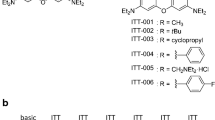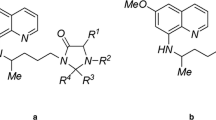Abstract
The seleno-organic compound ebselen showed anti-malarial activity in vitro against the murinePlasmodium berghei and the humanP. falciparum. InP. berghei, the uptake and incorporation of [3H]-methionine and [3H]-adenosine was inhibited and the infectivity of plasmodia was reduced. Ebselen affects the development of asexual stages of chloroquine-resistant and-sensitiveP. falciparum strains. Its IC50 forP. falciparum was about 14 μmol/l and that forP. berghei, about 10 μmol/l. The growth ofP falciparum was blocked by ebselen at all stages, including the invasion of erythrocytes by merozoites. In a human hepatoma cell line and in mouse peritoneal macrophages, no cytostatic or cytotoxic effects were found, indicating selective inhibition of plasmodia by ebselen. Its in vitro inhibitory effect is discussed in relation to its possible reactivity with thiol groups and its lack of an anti-malarial effect in infected mice.
Similar content being viewed by others
Abbreviations
- BSA:
-
bovine serum albumin
- FCS:
-
fetal calf serum
- GSH:
-
reduced glutathione
- GSSG:
-
oxidised glutathione
- HBSS:
-
Hanks' blanced salt solution
- PBS:
-
phosphate-buffered saline
- PE:
-
parasitised erythrocytes
- Se:
-
selenium
- TCA:
-
trichloroacetic acid
References
Assaraf YG, Golenser J, Spira DT, Bachrach U (1984) Polyamine levels and the activity of their biosynthetic enzymes in human erythrocytes infected with the malarial parasite,Plasmodium falciparum. Biochem J 222:815–819
Bayer B, Dieckmann A, Fritsch K-G, Kientsch R, Cunow D von, Spira DT, Schirmer RH, Wendel A, Jung A (1984) Glutathione metabolism ofPlasmodium vinckei andPlasmodium berghei. Hoppe-Seyler's Z Physiol Chem 365:965
Bhoon YK, Scovill JP, Klayman DL (1983) Planar nickel(II) and copper(II) complexes of potential antimalarial drugs, N4, N4-disubstituted thio and selenosemicarbazones of 2-acetylpyridine. Indian J Chem 22A:267–269
Bradford MM (1976) A rapid and sensitive method for the quantitation of microgram quantities of protein utilizing the principle of protein-dye binding. Anal Biochem 72:248–254
Colombatto S, Pezzali DC, Grillo MA (1987) Selenium and polyamine metabolism: different effect of selenite on liver and bursa of Fabricius ornithine decarboxylase activity. Int J Biochem 19:725–728
Desowitz RS, Barnwell JW (1980) Effect of selenium and dimethyl dioctadecyl ammonium bromide on the vaccine-induced immunity of Swiss Webster mice against malaria (Plasmodium berghei). Infect Immun 27:87–89
Eaton JW, Eckman JR (1979) Malaria infection and host cell oxidant damage. In: Caughey WS (ed) Biochemical and clinical aspects of oxygen. Academic Press, New York, pp 825–837
Eckman JR, Eaton JW (1979) Dependence of plasmodial glutathione metabolism on the host cell. Nature 278: 754–756
Eling W (1977a) Ficoll fractionation for the separation of parasitized erythrocytes from malaria infected blood. Bull WHO 55:105–114
Eling W (1977b) Separation of parasitized erythrocytes fromPlasmodium berghei infected mouse blood. Trans R Soc Trop Med Hyg 71:267–268
Fischer H, Terlinden R, Löhr JP, Römer A (1988) A novel biologically active seleno-organic compound: VIII. Biotransformation of ebselen: Xenobiotica (in press)
Flamigni F, Guarnieri C, Caldarera CM (1988) Rat liver cytosol contains NADPH-and GSH-dependent factors able to restore ornithine decarboxylase inactivated by removal of thiol reducing agents. Biochem J 250:53–58
Hanks JH, Wallace RE (1949) Relation of oxygen and temperature in the preservation of tissues by refrigeration. Proc Soc Exp Biol Med 71:196–200
Howard RJ, Smith PM, Mitchell GF (1978) Removal of leucocytes from red cells inPlasmodium berghei-infected mouse blood and purification of schizont-infected cells. Ann Trop Med Parasitol 72:573–575
Jänne J, Williams-Ashman HG (1971) On the purification ofl-ornithine decarboxylase from rat prostate and effects of thiol compounds on the enzyme. J Biol Chem 246:1725–1732
Jensen JB, Trager W (1977)Plasmodium falciparum in culture: use of outdated erythrocytes and description of the candle jar method. J Parasitol 63:883–886
Klayman DL, Scovill JP, Bartosevich JF, Mason CJ (1981) 2-Acetylpyridine thiosemicarbazones: 3. Selenium analogs as potential antimalarial agents. Eur J Med Chem 16:317–320
Klayman DL, Scovill JP, Bartosevich JF, Bruce J (1983) 2-Acetylpyridine thiosemicarbazones: 5. 1-[1-(2-Pyridyl)ethyl]-3-thiosemicarbazides as potential antimalarial agents. J Med Chem 26:35–39
Königk E, Putfarken B (1983) Inhibition of ornithine decarboxylase of in vitro culturedPlasmodiumfalciparum by chloroquine. Tropenmed Parasitol 34:1–3
Königk E, Mirtsch S, Putfarken B, Abdel-Rasoul S (1981)Plasmodium chabaudi-infection of mice: Effects of chloroquine and mefloquine. Inhibition of ornithine decarboxylase activity. Tropenmed Parasitol 32:73–76
Kosower NS, Kosower EM (1970) Molecular basis for selective advantage of glucose-6-phosphate-dehydrogenase-deficient individuals exposed to malaria. Lancet ii:1343–1344
Lambros C, Vanderberg JP (1979) Synchronization ofPlasmodium falciparum erythrocyte stages in culture. J Parasitol 65:418–420
McCann PP, Bacchi CJ, Hanson WL, Cain GD, Nathan HC, Hutner SH, Sjoerdsma A (1981) Effect on parastic protozoa of α-difluoromethylornithine — an inhibitor of ornithine decarboxylase. In: Caldarera CM, Zappia V, Bachrach U (eds) Advances in polyamine research, vol 3. Raven Press, New York, pp 97–110
Mercurio SD, Combs GF (1986) Synthetic seleno-organic compound with glutathione peroxidase-like activity in the chick. Biochem Pharmacol 35:4505–4509
Müller A, Cadenas E, Graf P, Sies H (1984) A novel biologically active seleno-organic compound: I. Glutathione peroxidase-like activity in vitro and antioxidant capacity of PZ 51 (ebselen). Biochem Pharmacol 33:3235–3239
Neame KD, Brownbill PA, Homewood CA (1974) The uptake and incorporation of nucleosides into normal erythrocytes and erythrocytes containingPlasmodium berghei. Parasitology 69:329–335
Parnham MJ, Kindt S (1984) A novel biologically active selenoorganic compound: III. Effects of PZ 51 (ebselen) on glutathione peroxidase and secretory activities of mouse macrophages. Biochem Pharmacol 33:3247–3250
Parnham MJ, Winkelmann J, Leyck S (1983) Macrophage, lymphocyte and chronic inflammatory responses in selenium deficient rodents. Association with decreased glutathione peroxidase activity. Int J Immunopharmacol 5:455–461
Parnham MJ, Leyck S, Kuhl P, Schalkwijk J v d Berg WB (1987) Ebselen: a new approach to the inhibition of peroxide-dependent inflammation. Int J Tissue React 9:45–50
Picard-Maureau A, Hempelmann E, Krämmer G, Jackisch R, Jung A (1975) Glutathionstatus inPlasmodium vinckei parasitierten Erythrozyten in Abhängigkeit vom intracrythrozytären Entwicklungsstadium des Parasiten. Tropenmed Parasitol 26:405–416
Scovill JP, Klayman DL, Franchino CF (1982) 2-Acetylpyridine thiosemicarbazones: 4. Complexes with transition metals as antimalarial and antileukemic agents. J Med Chem 25:1261–1264
Seth RK, Saini AS, Jaswal TS (1985)Plasmodium berghei: oxidant defense system. Exp Parasitol 60:414–416
Sherman IW, Tanigoshi L Mudd JB (1971) Incorporation of14C-amino acids by malaria (Plasmodium lophurae): II. Migration and incorporation of amino acids. Int J Biochem 2:27–40
Stocker R, Hunt NH, Buffinton GD, Weidemann MJ, Lewis-Hughes PH, Clark IA (1985) Oxidative stress and protective mechanisms in erythrocytes in relation toPlasmodium vinckei load. Proc Natl Acad Sci USA 82:548–551
Van Dyke K, Szustkiewicz C (1969) Apparent new modes of antimalarial action detected by inhibited incorporation of adenosine-8-3H into nucleic acids ofPlasmodium berghei. Mil Med 134:1000–1006
Warburton D (1984) Miscellaneous compounds. In: Peters W, Richards WHG (eds) Antimalarial drugs II. Springer-Verlag, Berlin Heidelberg New York Tokyo, pp 471–495
Wendel A, Fausel M, Safayhi H, Tiegs G, Otter R (1984) A novel biologically active seleno-organic compound: II. Activity of PZ 51 in relation to glutathione peroxidase. Biochem Pharmacol 33:3241–3245
Zhang Y (1987) Malaria: an intra-erythrocytic neoplasm? Parasitol Today 3:190–192
Zhang Y, Asante KSO, Jung A (1986) Stage-dependent inhibition of chloroquine onPlasmodium falciparum in vitro. J Parasitol 72:830–836
Zhang Y, Hempelmann E, Schirmer RH (1988a) Glutathione reductase inhibitors as potential, antimalarial drugs. Biochem Pharmacol 37:855–860
Zhang Y, König I, Schirmer RH (1988b) Glutathione reductase-deficient erythrocytes as host cells of malarial parasites. Biochem Pharmacol 37:861–865
Author information
Authors and Affiliations
Rights and permissions
About this article
Cite this article
Hüther, A.M., Zhang, Y., Sauer, A. et al. Antimalarial properties of ebselen. Parasitol Res 75, 353–360 (1989). https://doi.org/10.1007/BF00931130
Accepted:
Issue Date:
DOI: https://doi.org/10.1007/BF00931130




